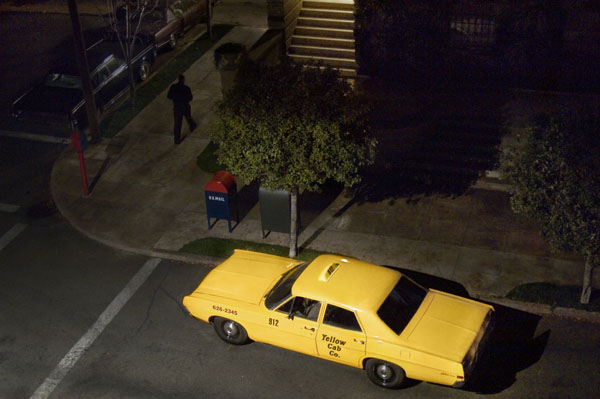The question at the top is posed in the subtitle of an essay-in-progress by Peter Labuza:
There is currently no set definition—the term is not only extremely new, but also founded on message boards instead of coined by a major critic or theorist—so it remains only vaguely defined. The closest “official” definition comes from Mubi writer Adam Cook: “A filmmaker who works within popular culture, making films defined by qualities of mass entertainment like genre, violence, pulp, etc. that still retains a thematic and aesthetic continuity over their body of work. They are often, but not always, mistakenly degraded for the supposed ‘vulgar’ nature of their work.” At its most basic, Vulgar Auteurism is about the work of unheralded contemporary directors of “disreputable quality”: [Paul W.S.] Anderson, Michael Bay, Neveldine/Taylor, and Tony Scott remain the most cited. While it can be seen in a tradition of Cahiers du Cinéma’s auteurist moment in the 1950s, as well as an extension of Andrew Sarris’s Expressive Esoterica category in The American Cinema, Vulgar Auteurism moves away from some of these properties and toward an appreciation of the image as an image. As the blogger Sean Gilman observes, “These arguments tend to focus on the artistry of the filmmakers’ image-construction over their thematic content (philosophical, political, etc) or narrative qualities (story, plot, character, dialogue, etc).” Gilman is both right and wrong: Vulgar Auteurism, as I will demonstrate, is primarily interested in the image (or better yet, the screen and the surface), which can only go so far in legitimating the films and filmmakers. But for its most articulate writers, Vulgar Autueurism examines the thematic weight of those images as well, which explore new paradigms of 21st century culture.
“Though it can sometimes seem unduly contrarian, vulgar auteurism is not about rejecting the old guard in favor of some frivolous new,” writes Calum Marsh in a recent piece for the Voice: “this is not a project founded on nonconformity for its own sake. It isn’t about reevaluating work that’s underrated so much as finally thinking seriously about work that isn’t thought about much at all. The problem it aims to correct isn’t that good movies have been called bad, but that interesting movies have been ignored. At its heart, the intentions of vulgar auteurism are pure: to treat ‘unserious’ cinema seriously. That is a noble pursuit.”
Introducing a new feature at Not Coming to a Theater Near You, Rumsey Taylor notes that “the failed franchise is a very peculiar type of film: a prologue that anticipates adventures that never happen, announcing a sometimes rich universe of characters who remain underestablished, an excerpt orphaned from a deeper narrative. Some are rife with potential, whereas others demonstrate film studios at their most unreservedly capitalistic. For the month of June, we’ll be delving headlong into failed franchises, outlining their lineage and idiosyncrasy.”
Interiors has launched a new column at ArchDaily. Topic #1: “If cinema is a matter of what’s in the frame, David Fincher is an artist who is very much concerned about all four corners of his canvas.”
Returning to the offices of frieze from the Venice Biennale, co-editor Dan Fox enumerates “an assortment of observations still nagging at me,” among them the “return of the film/video essay… A single narrator – often, though not always, that of the artist – advancing an argument about identity, politics, the nature of images and objects, or their value and methods of circulation, speaking over footage that might be directly related to the narrative, or have a looser, more associative relationship to it. In The Encyclopedic Palace this approach could be found in work by Ed Atkins, Camille Henrot, Harun Farocki, Helen Marten, Hito Steyerl and, a little more obliquely, Mark Leckey.” And “Duncan Campbell gave us an essay on art, value and Negritude, based on Chris Marker and Alain Resnais’s 1953 film Statues Also Die. (Marker’s work looms large over a few of these film and video essays.)”
Andrew Lampert recently spent five hours with Peter Kubelka, talking about “everything from café service in Vienna, pulling pranks on Theodor Adorno, and co-founding both the Austrian Film Museum and Anthology.” Also in the new issue of the Brooklyn Rail, Richard Langston offers a few reflections on an Austrian filmmaker of a very different sort, Kurt Kren, and his work with the Vienna Actionists.
Jonathan Kahana previews Anthology Film Archives’ retrospective of work by Shinsuke Ogawa (Friday through June 18), Robert C. Morgan looks back on a recent exhibition of work by Bruce Conner, and Rachael Rakes reviews Gianfranco Rosi and Charles Bowden’s El Sicario, Room 164 (2011).
“Both [Burt] Lancaster and [Robert] Aldrich were big, willful men with a powerful sense of their own heroic destinies as artists,” writes Nick Pinkerton in an essay on the films they made together for Film Comment. “As such, they weren’t destined for a long collaboration of the sort that Anthony Mann and James Stewart managed. In the years between Vera Cruz [1954] and their 1972 reunion [on Ulzana’s Raid], each man had faced his share of triumphs and setbacks. When Ulzana’s Raid came along, Aldrich was in one of his bust periods, divesting himself of the studio he’d bought in the wake of the success of The Dirty Dozen, after a string of box-office failures. Back to the wall, the director returned to his origins to make one of his very greatest films.”
Jonathan Rosenbaum‘s posted a transcription of his 2001 conversation with Béla Tarr.
Tyler Coates‘s interview with William Friedkin for Flavorwire focuses on The Boys in the Band (1970) and Cruising (1980): “I honestly have never thought the idea that these were ‘gay movies made by a straight director.'”
For Sight & Sound, Colm McAuliffe talks with Vicki Bennett, the remix artist known as People Like Us: “I really believe the work we make isn’t ours, it already exists, it’s folk culture. I’m a folk artist working in a digital age, or the age of mechanical reproduction.”
In other news. “Long-lost films by John Ford, Mabel Normand, and Alfred Hitchcock are brought back to life in the 3-1/4-hour DVD, Lost and Found: American Treasures from the New Zealand Film Archive,” announces the National Film Preservation Foundation. The DVD will be available in September.
List. The Telegraph‘s Tim Robey has notes on his top ten films from the silent era.
New York. “Film Society of Lincoln Center and Subway Cinema have announced full details about this year’s New York Asian Film Festival, including a full-to-bursting lineup of some of the best new movies from the continent.”
Tonight at Light Industry: Michele O’Marah’s Valley Girl, which “captures and intensifies the heart and soul of Martha Coolidge’s original 1983 crossover hit.”
Austin. If you attend tomorrow night’s Before Midnight Feast at the Alamo Drafthouse on Slaughter Lane, chances are you’ll see a custom-made advisory, warning you to turn off your damn phone.
London. There’s more than the Herzog season going on at the BFI. June’s schedule also features Seasons in the Sun: The Heyday of Nikkatsu Studios and Rita Hayworth (see the BFI’s collection of vintage posters). Gaby Wood in the Telegraph: “Long after her glory days, somewhere between alcoholism and Alzheimer’s, Hayworth remembered as her only cinematic triumphs not her work with Orson Welles or Howard Hawks or Charles Vidor but the two musicals she made with Fred Astaire: You’ll Never Get Rich (1941) and You Were Never Lovelier (1942). She was a light, witty, girlish dancer—the conversational preamble to a dance number might have involved cryptic half-smiles and a slightly raised eyebrow, but when the music started she was uncontainably vivid.”
In the works. David Lynch will follow up his album Crazy Clown Time with another: The Big Dream will be out on July 16, reports FACT, where you can hear the first single, “I’m Waiting Here,” featuring Lykke Li. As a sort of tie-in, Lynch has posted his first video short on Vine.
TheWrap‘s Jeff Sneider reports that some sort of something related to Blade Runner (1982), maybe a prequel, maybe a sequel, is (probably) taking shape.
The Guardian‘s Ben Child reports on the rumor that Penélope Cruz will be the next Bond girl in Sam Mendes’s followup to Skyfall.
Ignatiy Vishnevetsky teases Ellie Lumme:
Obits. From Bruce Weber in the New York Times: “Jean Stapleton, the character actress whose portrayal of a slow-witted, big-hearted and submissive—up to a point—housewife on the groundbreaking series All in the Family made her, along with Mary Tyler Moore and Bea Arthur, not only one of the foremost women in television comedy in the 1970s but a symbol of emergent feminism in American popular culture, died on Friday at her home in New York City. She was 90.” Related viewing: Henry Fonda introduces a compilation of the best of Edith Bunker.
And from Douglas Martin: “Jean Bach, a lifelong jazz zealot whose fascination with a photograph of the titans of jazz gathered in front of a Harlem brownstone in 1958 led her to make a prizewinning movie about that moment, A Great Day in Harlem, 36 years later, died [last] Monday at her home in Manhattan. She was 94.”
“Jiah Khan, a 25-year-old Bollywood actress, was found hanging in her Mumbai home on Monday,” reports the Telegraph‘s Alice Vincent. “The actress was best known for her role in Indian psychological thriller Ghajini. The daughter of Indian American Ali Rzvi Kahn and Rabiya Amin, a Hindi film actress, she started her film career in the 2007 film Nishabd opposite Bollywood star Amitabh Bachchan, who played a much older lover. Her death has shocked the film industry,” and the Times of India collects initial reactions to the news as well as tributes.
“Very sorry to learn of the death, on May 29, of French actress Françoise Blanchard at the much too young age of 58,” writes Tim Lucas. “She was best known for playing the title role in Jean Rollin‘s The Living Dead Girl; it is one of the most moving performances to be found in his work.”
More browsing? See the Film Doctor and Mike Everleth.
For news and tips throughout the day every day, follow @KeyframeDaily on Twitter and/or the RSS feed. Get Keyframe Daily in your inbox by signing in at fandor.com/daily.





